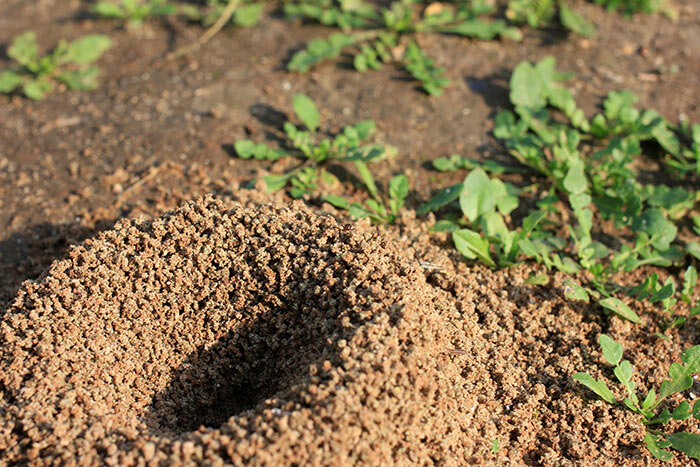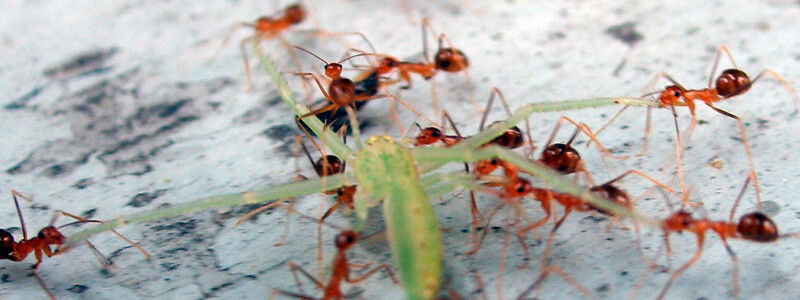Just mention Fire Ants, and you have an instant conversation anywhere in Texas. Everyone can add a comment, an observation, a story. Home remedies are offered; someone else’s remedy is suggested; each person’s own favored product is proclaimed to be the Best Way. In all these conversations, we’re asking each other “What” to use, when we what we should be asking is “How” and “When” to use it. The best, most effective product in the world won’t work if it isn’t used at the right time, and in the right manner.
Why Control Fire Ants
To understand why this is so, you need to know a few facts about Fire Ants. First, Fire Ants CANNOT EAT SOLID FOOD. They have a screen in their throats that won’t pass particles larger than a micron, and so they must take every scrap of food back to the mound, where it is digested by one of the larval stages and turn into a semiliquid state. Then, that food is shared within the mound, first by the worker ants, who feed it to one another and then by the Queen. They feed each other first, so that if anything goes wrong, the expendable worker ant dies, not the Queen. She only gets the good stuff! This process can take up to three days, so that whatever is in the bait product can’t be too fast-acting, or the Queen won’t get it. As everyone knows by now, the Queen is the one who must be killed. A typical mound can contain some 80,000 or so worker ants; the Queen . . . or Queens, because in some areas there are multiple-queen mounds . . . can lay her own weight in eggs each day. That, of course, is why it is so very difficult to get rid of Fire Ants.

Also, you must know that the Fire Ants live their whole lives for one purpose only: to preserve and protect their Queen. Taking care of the Queen and the brood is the worker ant’s whole reason for being. At the first sign of danger, the worker ants scurry towards the Queen and move her to safety in tunnels deep within the mound, and these tunnels can stretch yards away from the mound.
Finally, there is the fact that Fire Ant mounds are not always visible. You see them in the spring, you see them after a good rain, but in our hot, dry summers, you rarely see a mound. But the Fire Ants are still there, never doubt it! They are just very sensibly staying deep indoors until it cools off. In summer, the foraging ants look for food after the sun goes down.
How to Get Rid of Fire Ants
Now, what most people really want to know about Fire Ants is how to get rid of them! There are two methods of Fire Ant Control: BAITS, which is material the Fire Ants perceive as food, and INDIVIDUAL MOUND TREATMENTS. And we need both methods to do the job right.
We must use baits since we’ll never be able to find every single mound. Some may even be inside the house since Fire Ants are attracted to electricity. They’ve been found in houses, inside the electrical wall plugs. Outside, they’ve been known to short out air conditioning compressors. Fire Ants seek water during dry periods and may enter houses through plumbing outlets. But inside or outside, worker ants are looking for food. They’ll find the bait, carry it back to the mound, and in effect, do all the work for you. A prominent Fire Ant expert refers to one of the baits as a “Trojan Horse” for just this reason.
There are many very promising organic baits now on the market: one is a substance called Spinosad, which is marketed under the trade name “Conserve,” among others. Another material, Indoxicarb, is a new class of control products; it is marketed as “Advion.” Researchers are getting excellent results with these new products.
Now, these baits may be very effective, but they’re certainly not cheap. It’s vital that we use them at the right time and in the right manner. That brings us to the “When” question.
When to Treat Fire Ants
In the spring, when it’s warm enough to set out tomatoes, is the right time to broadcast Fire Ant bait. Wait until the dew has dried (water ruins the baits) and then broadcast the bait at the labeled rate. (And yes, please DO read and follow that label!) Fire Ant workers usually find and retrieve the bait within an hour after it is put out, so if it rains six hours later, don’t despair: your bait will still work most probably.
Once summer has set in, worker ants forage in the cool of the evening and at night, so wait until then to put out the bait. If you put it out in the heat of the day, it will get rancid before the ants find it. Baits are coated with oil, which is what attracts the ants; it’s important that baits are kept inside, under air conditioning, so that they’ll stay fresh. Now, I’ve seen it advised that baits can be broadcast in the fall, right up until the first frost, but my own experience (I used to work at killing Fire Ants for a living, working for the Texas Department of Agriculture about 20 years ago) tells me that the baits don’t work very well even early in the fall.
The ants will pick up the bait, yes, but they won’t eat it; instead, they’ll use it for building material. T. D. A. researchers have dug up mounds where the honeycombed mounds were all a telltale yellow. This was in areas that had been treated with baits in the fall, and since baits are sometimes made up of ground-up corncob grits, and impregnated with oil, they have a yellow color; so it was obvious what had happened. Fire Ants need oil as part of their reproduction process. Mating flights take place in spring and early summer, therefore, by fall, they’re no longer using the oily bait as food. Nature is indeed strange!
Individual Mound Treatments
The “How” question applies most often to the other method of Fire Ant Control: Individual Mound Treatments. When we have “nuisance” mounds that we need to deal with immediately, we turn to these. Organic Mound Treatments often contain limonene, an extract of orange oil. Citrex, Safer Fire Ant Killer, and Orange Guard are some brand names, among others. How you use them is, first (again I tell you what you’ve heard so often before) read the label! And then, having mixed the proper amount of drench, at the proper rate, you then approach the mound very, very quietly. You want to sneak up on them: Fire Ants are hard enough to kill, without us giving them fair warning. Then quickly and thoroughly drench the mound and go away quickly. You can go back later if you want to see if they’re gone.
Home Remedies
Finally, I’d like to say a word about some of those home remedies, specifically the grits, or cornmeal, school of Fire Ant Control. They eat the grits, so the theory goes, then they drink water, and the grits or cornmeal swells up inside their stomachs, and they blow up. The trouble with this theory is that the Fire Ants don’t do any such thing. As stated before, they can’t eat solid food, of any kind. Now, it may be true that, by dumping grits or whatever on top of their mound, you can make the Fire Ants move. They don’t like their mounds being disturbed, so sometimes they’ll pack up and move . . . not far away, however. You could get the same result with a like amount of sawdust, no doubt. So don’t believe all you hear, even if it’s from an otherwise reliable source.
In the long run, we may never find a product that gets rid of Fire Ants once and for all. We haven’t found a cure for the common cold, either. But if we use our common sense, pay attention to new research, and oh, yes, READ THE LABEL we can take back our yards from our common enemy, the Red Imported Fire Ant. So be of good heart, keep the faith, and don’t get stung!

